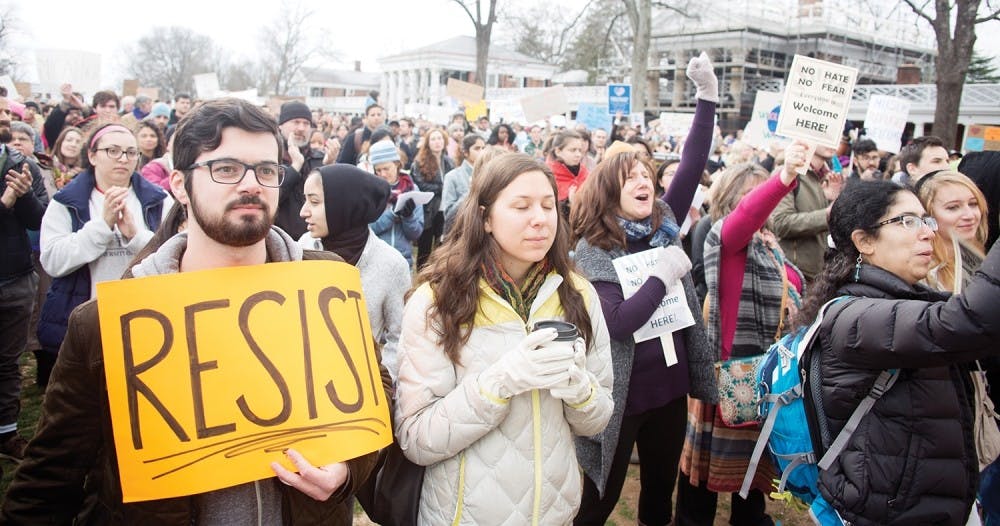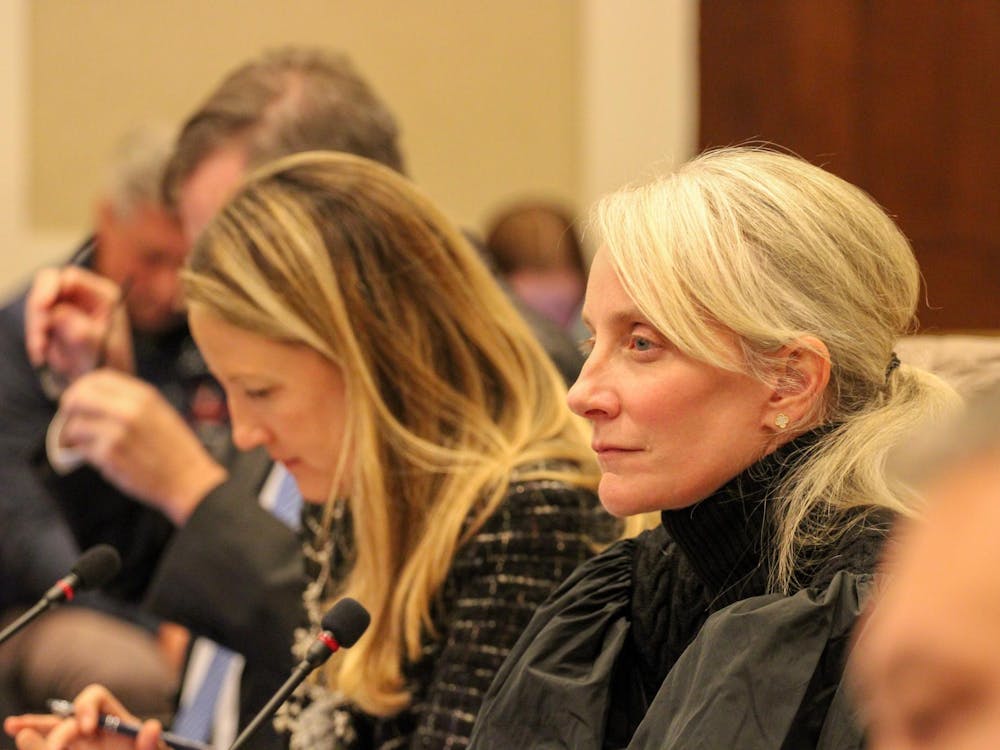From spontaneous protests to carefully coordinated events, a plethora of student and community organizations have worked to make their voices heard through activism efforts on Grounds this year.
Throughout a contentious election season and with the onset of Donald Trump’s presidency, groups of University students have organized protests, rallies and teach-ins — many in opposition to Trump’s administration and policies.
Attiya Latif, a third-year College student and incoming student director of the Multicultural Student Center, said student activism is a resistant force for mobilizing students out of collective apathy.
“It galvanizes students into action and raises administrative awareness so that progress can be made and the student voice can be heard,” Latif said. “Without protest, without action, without a public voice of disapproval or a demand for change, no change can be made.”
The day after the inauguration, a Women’s March was held in Washington D.C., drawing nearly 500,000 people. While many University students attended, some of those involved with the sorority rush process were concerned that the march's conflict with rush events would leave them unable to participate.
The Inter-Sorority Council responded by organizing a subsequent women’s march at the University to ensure all could participate.
As incoming chair of the Minority Rights Coalition, third-year Commerce student Evelyn Wang said she sees student activism as being critical to to the future of the University.
“In order to be a student activist at U.Va., one must have enough passion and faith in this institution to believe it's capable of growth and change,” Wang said.
When an executive order barred refugees and those traveling from seven Muslim-majority countries to enter the United States if they were not U.S. citizens, several University students quickly organized a protest on the Lawn, again carrying banners and signs touting messages of a loving community for refugees.
DREAMers on Grounds, the Minority Rights Coalition and other student groups arranged the March for Muslim, Immigrant and International Students' Rights, and messages such as “the people united will never be defeated” and “Hoos against hate” were chanted.
Wang stressed that much of the work is done by student activists behind the scenes.
“Most people are apathetic about issues that don't directly affect them,” Wang said. “However, when these people see local and national problems affecting friends and family, they are usually motivated to act. Thus, minority student leaders and student activists should work to make these issues more real to those in the community who remain apathetic by having one-on-one conversations and bringing the human element.”
Numerous teach-ins meant to educate students on social and political activism have also been held this year.
Hannah Borja, a second-year College student and a member of the DREAMers on Grounds executive board, was one student who helped lead several events and has campaigned for the support of the undocumented and immigrant community in Charlottesville, even interrupting a Board of Visitors meeting this year to express student concerns.

“I think student activism is too often treated as a commodity or a means to social-climb into certain positions or inner circles,” Borja said. “This frustrates me because every minute of manipulating the politics of student activism on Grounds is a minute not dedicated to helping marginalized populations.”
Professors from various departments also gave presentations as part of these teach-ins, after which students could address the panel in a question and answer session.
Asst. History Prof. Andrew Kahrl, who has been involved with some of the teach-ins, said student leaders were primarily focused on coordinating an event that woulds ensure that their efforts produced involvement that was sustained over time.
“Students really want to continue the work past these pivotal moments,” Kahrl said.
The student leaders wanted to not only voice their views on key issues, but also to keep the momentum going past these singular moments of activism, he said.
“One of the more encouraging signs that I’ve seen here is that you’ve actually seen evidence of student organizations trying to form partnerships with community organizations,” Kahrl said.
He referenced the Garrett town hall protest as an instance in which students and local community members worked together to increase activism and awareness. University Democrats organized the protest, which included a democracy fair that featured various groups from the community as well as University organizations.
“It usually takes a certain kind of moment — whether it be something that sort of galvanizes the public, or whether it be a prearranged events that students can sort of rally around or in opposition to,” Kahrl said.
Brian Cameron, a second-year College student and treasurer of the Climate Action Society, took part in the protest, along with several other direct actions over the past year.
“As evidenced by the numerous racist, sexist, homophobic and transphobic slurs and direct verbal harassment levied by Garrett supporters outside the event, our voices were necessary to call out that this is not normal and that minority students are alway welcome on Grounds,” Cameron said.
Politics Prof. David Leblang said student activism can sometimes make it harder for opposing viewpoints to be realized.
“We should exist, especially on a college campus, in an environment where people can exchange ideas freely and without worry of repercussions,” Leblang said. “I do worry that in the current atmosphere of activism that opposing views were being silenced.”
Leblang gave the example of students who protested Ann Coulter being scheduled to speak at the University of California, Berkeley. Due to the protests, Coulter’s speaking engagement was cancelled.
“I want to hear what Ann Coulter has to say,” Leblang said. “If we just shut her down or don’t give her an opportunity to speak, then we don't understand how a reasonable segment of the country feels about something.”
Leblang noted that though there was a significant amount of student activism this year, such is usually the case during an election cycle.
“We see a lot of activism in election years, and I think this election turned out in ways that people didn’t expect,” Leblang said. “Any time you have something that's surprising, students tend to become more active.”
Leblang mentioned the response to Rolling Stone’s November 2014 publication of “A Rape On Campus” as a moment when students rallied around a cause following an event that impacted the community.
The now-retracted article detailed an alleged gang rape of a University student named “Jackie,” but a subsequent Charlottesville Police investigation found no evidence to support the article’s claims. The article was later retracted in April 2015.
In the days following the article’s publication, a “Slut Walk” was organized for protesters to make their voices heard by Dean of Students Allen Groves, as well as other administrators, and declare they wanted change for how the University handles sexual assault cases. Faculty also hosted a rally called “Take Back the Party: End Rape Now” where several hundred University members gathered by Beta Bridge to protest.
“It was something shocking, something that people don't expect, and that causes people to join together, to mobilize and to realize that they have things in common that they might not have appreciated prior,” Leblang said.
Kahrl said an integral part of student activism is ensuring the longevity of students’ efforts, which necessitates working closely with the local community going forward.
“I think [that] will be a key toward continuing this organizing and then ultimately mobilizing efforts — to not have organizations here on campus isolated from the surrounding community,” Kahrl said. “Having those collaborative efforts between students and the larger community is essential really to ensuring that you don’t see these efforts peter out.”








